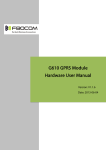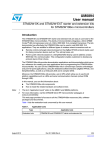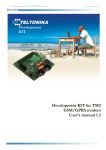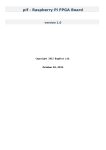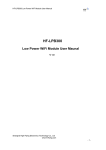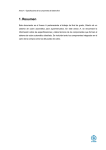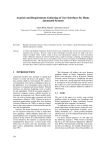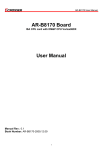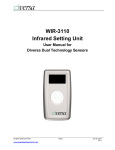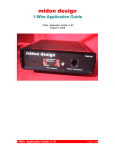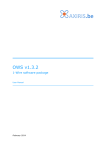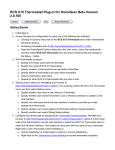Download Manual - UniPi
Transcript
UniPi technical documentation REV 1.1 UniPi Contents Overview.................................................................................................................................................. 2 Description .............................................................................................................................................. 3 GPIO port map ..................................................................................................................................... 4 Power Requirements ........................................................................................................................... 5 Connecting Raspberry Pi to UniPi........................................................................................................ 5 Building blocks ......................................................................................................................................... 5 Relays................................................................................................................................................... 5 Digital Inputs ....................................................................................................................................... 5 5-12V Step-up (internal 12V power supply) .................................................................................... 6 Jumper settings ............................................................................................................................... 6 Analog Inputs....................................................................................................................................... 6 EEPROM ............................................................................................................................................... 7 Analog Output ..................................................................................................................................... 7 1Wire sensors ...................................................................................................................................... 8 UART .................................................................................................................................................... 8 I2C ports ............................................................................................................................................... 9 Technical parameters ............................................................................................................................ 10 Onboard I2C ICs.................................................................................................................................. 10 Relays................................................................................................................................................. 10 Digital Inputs ..................................................................................................................................... 10 Analog Output ................................................................................................................................... 10 Power Requirements ......................................................................................................................... 10 Dimensions ........................................................................................................................................ 10 Revision History ..................................................................................................................................... 11 Changes ............................................................................................................................................. 11 WWW. UNIPI. TECHNOLOGY 1 REV 1.1 UniPi Overview UniPi is an add-on board for the Raspberry Pi (RPi). It features many components such as 12 (+2) digital inputs with LED signalization, two 0-10V analog inputs, one 0-10V analog output, changeover relays, single channel 1wire master controller and a real-time clock module. The two digital inputs 13,14 and the I2C_0 bus are meant to connect via the P5 header of RPi B (only) which is no longer available on newer Raspberry Pis (B+ and newer). We provide basic open-source Python library for interfacing the UniPi available on GitHub which is recommended to use. There are also many platforms and libraries that are compatible with UniPi: • • • • • REX – Industrial PLC automation tool FHEM – Home automation GNU/GPL v.2 Perl server Wyliodrin – Online visual programming service HomeSeer – Another home automation system Others… See www.unipi.technology UniPi is fully compatible with Raspberry Pi (models A, A+, B, B+, B+ model 2) and mounting-hole compatible with BeagleBone Black. However we do not provide support for BeagleBone. Please note the UniPi is only compatible with Raspberry Pi model B rev 2. Connecting model B rev. 1 is also possible provided checking the Raspberry Pi official documentation. WWW. UNIPI. TECHNOLOGY 2 REV 1.1 UniPi Description Major building blocks of UniPi: • • • • • • • • • • • • • • Relays: 8 relays 250VAC@5A or 24VDC@5A – control switching elements UART port: Standard serial port to connect serial console or many other devices (NFC readers, … ) 1Wire port: Provides 1Wire bus interface to connect 1Wire devices such as temperature and humidity sensors I2C port: For connecting other extension modules for example relay or analog output modules I2C configuration pins: To connect the I2C_0 bus from the RPi (only for advanced users) RTC (Real Time Clock) module: Provides real time in case of internet or power outage (backup battery not included in the package). Power 5V: 2.1mm connector for power supply RPI connector: 26-pin connector for Raspberry Pi Digital inputs: 12(+2) galvanically isolated digital inputs for reading signals from external devices 12V out: Power supply 12V@200mA - only for use with digital inputs of the UniPi Configurable ports: To configure digital inputs for use with external power source Analog in: Two 0-10V analog inputs for reading analog signals from external devices Analog out: One 0-10V analog output for proportional controlling AO trimmer: For precise adjustment of the analog output Figure 1 - The UniPi WWW. UNIPI. TECHNOLOGY 3 REV 1.1 UniPi GPIO port map Table 1 – Raspberry Pi P1 header map UniPi AO I01 I02 I03 I04 I05 I06 I07 I08 I09 I10 I11 I12 I2C1_SCL I2C1_SDA UART RX UART TX RPi BCM GPIO18 GPIO04 GPIO17 GPIO27 GPIO23 GPIO22 GPIO24 GPIO11 GPIO07 GPIO08 GPIO09 GPIO25 GPIO10 GPIO02 GPIO03 GPIO15 GPIO14 Function PWM Digital Input Digital Input Digital Input Digital Input Digital Input Digital Input Digital Input Digital Input Digital Input Digital Input Digital Input Digital Input I2C1_SCL I2C1_SDA UART0_RXD UART0_TXD Description Analog Output 0-10V Digital Input Digital Input Digital Input Digital Input Digital Input Digital Input Digital Input Digital Input Digital Input Digital Input Digital Input Digital Input Internal I2C_1, RJ11 connector UART RJ11 connector Table 2 – Raspberry Pi P5 header map UniPi I13 I14 I2C0_SCL I2C0_SDA RPi BCM GPIO31 GPIO30 GPIO29 GPIO28 Function Digital Input Digital Input I2C0_SCL I2C0_SDA Description Digital Input Digital Input External I2C_1 Table 3 – MCP23008 pin map Relay 8 7 6 5 4 3 2 1 MCP23008 GP0 GP1 GP2 GP3 GP4 GP5 GP6 GP7 WWW. UNIPI. TECHNOLOGY 4 REV 1.1 UniPi Power Requirements There are two options of powering the UniPi board and Raspberry Pi: • Single power source (RPi and UniPi are powered from the same power source) • jumper JP1 mounted • 5V DC 2A through the UniPi power connector (1.5A for UniPi + RPi requirements) • Please note that UniPi can only provide 750mA to the RPi (max 1.1A in newest versions of UniPi) • Raspberry Pi micro USB power connector not used • Dual power source (separate power source for each UniPi and Raspberry Pi) • jumper JP1 dismounted • Raspberry Pi powered from the micro USB port according to the RPi requirements • 5V DC 1.5A through the UniPi power connector Attention: • Powering the UniPi from the Raspberry Pi is not recommended and could damage the Raspberry Pi. • When using the Raspberry Pi in heavy load and multiple peripherals connected we recommend dual power source solution. Connecting Raspberry Pi to UniPi Before the first use plug in a CR2032 battery to the battery holder. Connecting UniPi to Raspberry Pi is straight forward: 1. 2. 3. 4. 5. 6. Make sure you have properly configured the power jumper – see powering requirements Screw the spacers to the mounting holes of the UniPi Connect the provided flat cable to the RPi connector Screw the Raspberry Pi to the UniPi Connect the other end of the flat cable to the RPi (make sure it is not twisted) Plug in the power supply Building blocks Relays Maximum relay switching power is limited to 250V AC/5A or 24V DC/5A, voltages over this limit must be switched using external relay or contactor. Relays are controller by the MCP23008 (address 0x20), see map of MCP’s GPIO to relays in Table 3 . Each relay has a LED indicating its state. There are three contacts for each relay named CO (change-over or C=connected), NO (normally opened), NC (normally closed). By default contacts CO and NC are connected (NO is not connected), by switching the relay on, CO gets connected to NO (NC is disconnected). Digital Inputs These inputs can be triggered by 5-24V DC voltage with minimum pulse length of 5ms. For easy visual reading of their states all inputs are equipped with LED. When using the GPIOs make sure to set a software pull-up resistor on each GPIO to make it work properly otherwise state of the GPIO cannot be read properly. WWW. UNIPI. TECHNOLOGY 5 REV 1.1 UniPi 5-12V Step-up (internal 12V power supply) All inputs are primarily set to be driven by the internal 12V power supply. The 12V line is wired out via the orange connector marked as 12V. Do not exceed 200ma current draw. Jumper settings In case of using external power source, inputs must be configured by JP2 - JP5 jumpers. The configuration must be done before powering up the UniPi. Using the external power supply and proper jumper configuration provides galvanic isolation for its inputs. Jumper configuration when using external power source: • JP2 o o o • JP3 o o o • When switched to the side of the JP3 label, inputs I01 and I02 act as inputs for signal from the connected peripheral device via the external power source. The ground of power supply for this inputs must be connected to the P02. Please note that to set I01 and I02 for ext. power source make sure to switch JP2 first and then JP3, after that you can safely connect the peripheral device. JP4 o o • Switching this jumper to the side of the JP2 label causes the P02 (green connector) to act as an input for ground from the external power source. Otherwise P02 is connected to the internal 12V. This step must be done as first when changing jumper settings. Please note that after this step, the GND of UniPi is connected to P02! Make sure to proceed with JP3 settings after this step. When switched to the side of the JP4 label, inputs I03 and I04 act as inputs for signal from the connected peripherals via the external power source. The ground of power supply for this inputs must be connected to P01. JP5 o o o When switched to the side of the JP5 label, inputs I05 - I14 act as inputs for signal from the connected peripherals via the external power source. The ground of power supply for this inputs must be connected to P01. Please note that I13 and I14 are wired out via the P5 header of Raspberry Pi (models before the PLUS versions). Analog Inputs UniPi features two analog 0-10V input channels (via the MCP3422, address 0x68) marked as AI1 and AI2. Each channel has its own + and – (e.g. AI1+ and AI1-). The + connector expects positive voltage from the connected device and – expects the negative pole (the GND). The guaranteed accuracy is 5% however 1% is commonly reachable. To correctly calculate the input voltage, a coefficient of the resistor divider has to be taken into account. The coefficient of each channel is saved in EEPROM as single precision binary floating point format binary32 (IEEE 754). Before version 1.1 the coefficient is not saved in the EEPROM and thus must be calculated during conversion in software (Typically the value is around 5.56). See chapter EEPROM for more details. 1 WWW. UNIPI. TECHNOLOGY 6 REV 1.1 UniPi EEPROM UniPi features onboard EEPROM (24C02) for storing important information with 2k bit memory organized into single block of 256 * 8-bit. We reserve address space 0xe0 – 0xff the rest is left for user space. The rest of unused reserved bytes are nulled.1 Table 4 - memory organization Starting address 0xe0 0xe2 0xf0 0xf4 Number of bytes 2 2 4 4 Example fa-55 1.1 0x40b089c5 (5.516818) 0x40b08b44 (5.517) Description UniPi identification UniPi version AI1 coefficient AI2 coefficient Analog Output Analog output is driven by the GPIO 18 PWM signal and is designed to run at 400Hz. The GPIO port is galvanically isolated from the rest of the output. The maximum current driven from this output is 20mA. This output is meant to control 3rd party devices that can adjust its power according to the 010V. The precision of AO in UniPi v1.0 is +-5% but also depends of the Raspberry Pi CPU usage. External voltage must be connected to the AOV connector with maximum voltage of 35V DC. Make sure to adjust output voltage using the blue trimmer (labeled as R49) before connecting devices to avoid causing damage. Behavior of the AO has changed since the UniPi version 1.1 (incl.). Before that 100% duty cycle on PWM meant to output 0V, and 0% DC (or permanent low) meant 10V. But after the version 1.1 (including v 1.1) the process is different and more logic meaning 100% duty cycle is 10V and 0% is 0V. 1 WWW. UNIPI. TECHNOLOGY 7 REV 1.1 UniPi 1Wire sensors UniPi features single channel 1Wire master controller (DS2482-100, address 0x18). The 1Wire bus is wired out via the RJ45 connector (see Table 5 for detailed description). The data line is ESD protected and the 5V power current is limited to 200mA. Table 5 - 1Wire RJ45 connector RJ11 pin 1 2 3 4 5 6 7 8 Function 5V DATA DATA GND UART The UART interface of Raspberry Pi is wired out via the RJ11 connector labeled UART. See Table 6 UART RJ11 connector. This port does not have any protection, so make sure to be careful when connecting devices. Operating voltage of this port is 3V3. Table 6 - UART RJ11 connector RJ11 pin 1 2 3 4 5 6 Function 5V RX TX GND - WWW. UNIPI. TECHNOLOGY 8 REV 1.1 UniPi I2C ports Raspberry Pi has two I2C interfaces. The I2C _1 of the RPi is connected via the main P1 connector and does not need any special modification. All the onboard ICs are connected to this bus. The second I2C bus, I2C_0, is wired out via the P5 connector which needs to be soldered from the bottom of the Raspberry Pi. Please check our online tutorial for further information. The I2C _1 is by default wired out via the onboard RJ11 connector labeled I2C and features ESD protection. UniPi also features optional I2C port (labeled I2C_1) on the edge of the board but does not have any connector by default. Please note that the I2C_0 has been reserved for special purpose starting with RPi models + and thus is no longer recommended to use.1 Table 7 - I2C RJ11 connector RJ11 pin 1 2 3 4 5 6 Function 5V I2C data (SDA) I2C clock (SCL) GND - WWW. UNIPI. TECHNOLOGY 9 REV 1.1 UniPi Technical parameters Onboard I2C ICs All onboard I2C chips are connected to the main bus. Table 8 - I2C chip addresses Chip type MCP23008 DS2482-100 MCP79410 MCP3422 24AA00/24C02 Address 0x20 0x18 0x6F, 0x57 0x68 0x50-0x57 Usage Relays 1Wire master Real Time Clock ADC EEPROM Relays • • Version 1.0: 8x Omron G5LA-1-E: 250V AC/5A or 24V DC/5A Version 1.1: 8x Finder 36.11.9.005.4001 Digital Inputs • 12(+2)x 5-24V DC Analog Output • • Maximum supply voltage: 35V Maximum output current: 20mA Power Requirements • • • The main UniPi power connector is standard 2.1mm inner diameter, 5.5mm outer diameter 5V DC 2A in single power supply mode (JP1 connected) o Attention: UniPi can supply only 750mA (1.1A in newest version) to the RPi When JP1 disconnected o 5V DC 1.5A for UniPi o 5V DC min 1A for Raspberry Pi (according to the RPi manual) Dimensions Width: 198mm Height: 86mm Depth: 16mm (without the RPi, cable and spacers) Weight: 0.21kg WWW. UNIPI. TECHNOLOGY 10 REV 1.1 UniPi Revision History Revision Release date Author 1.0 6. 11. 2014 Tomas Hora 1.1 4. 3. 2015 Tomas Hora & Imas NV Changes 1 Introduced in version 1.1 Thanks to Imas NV, Turnhout, Belgium for correction. Raspberry Pi is a trademark of the Raspberry Pi Foundation. WWW. UNIPI. TECHNOLOGY 11 REV 1.1















